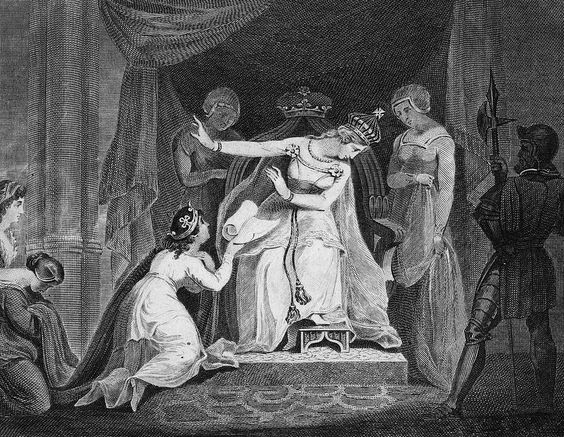The Plantagenet dynasty began with the marriage of the empress Matilda, daughter of Henry I of England, to Geoffrey Count of Anjou (d.1151) a grandson of William The Conqueror. He had the nickname ‘Plantgenet’ (lit. broom-planter) because he planted broom extensively to improve his hunting covers and always wore a sprig of broom on the rim of his hat. Curiously, the Parliament army at the battle of Knocknanuss 1647, wore the same plant for a badge on their hats .
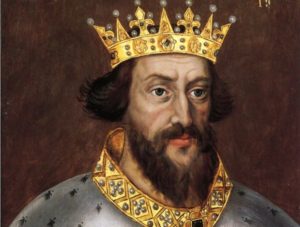
Geoffrey’s son Henry, Duke of Normandy 1150 and Count of Anjou 1151, was crowned Henry II of England in 1154. His reign lasted 35 years. He sons included Richard Lionheart and John Prince of Ireland. Henry introduced great reform for the working people. He reduced the power of the Barons and gave Tax Charters to towns while he completely reformed the justice system and put all forms of Government under the King. He was also responsible for developing trial by petty jury (12) and Curea Regis and brought all clergy under the law of the land. In 1184, at sixteen years of age, Prince John arrived in Ireland under instruction from his father to grant lands to his father’s friends and to build a line of castles along the dividing line between Gaelic and Norman property in Cork and Limerick. They were located at Carrigtwohill, Lohort, Lisgriffin, Liscarrol, Kilbolane and Limerick City.
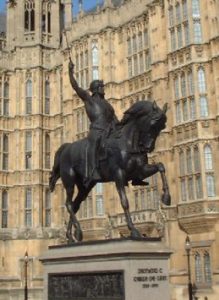
Henry I was succeeded by his eldest surviving son Richard (Lionheart) in 1189. Richard spent most of his time on the crusades and his mother Eleanor ruled England. Richard died in 1199. John, Richard’s younger brother became king in 1199. He was a weak ruler and was responsible for the undoing of much of the good done by his father. Circumstances deteriorated so much that the people drew up a charter and forced John to sign it. This charter was called the Magna Carta. He lost Anjou, Main, Normandy, and Touraine in 1204. His mother died in 1205, as did his friend Hubert Walter, Archbishop of Canterbury. The death of the archbishop led to a conflict between the then pope and King John. Pope Innocent III elected Stephen Langton as Archbishop of Canterbury. As a result of John’s objection to this appointment England was placed under Interdict (all churches closed). In addition John was excommunicated, an event that illustrated for all the civilised world the enormous power wielded by the pope. King John agreed to hold England as a fief of the Pope at a cost of 1,000 marks per year. John died on October 19, 1216.
He was succeeded by his elder son Henry who was 9 years old when he was crowned as King Henry III. The reign of Henry III was through troubled times in England. The Pope extracted vast amounts of money from the king for very dubious reasons. At the Council of Lyon in 1245 Henry complained that he was paying the Pope 60,000 marks per year. By 1257 he was paying 135,000 marks per year.
The following year, England was so much in debt that a parliament known as “The Mad Parliament of Oxford” was convened. It was convened by Simon de Montfort and Richard Earl of Gloucester to reform the administration. This was the first Parliament. The first reform provided for 24 persons to reform the grievances of state and church. Another body of 15 men was to advise the king. These two bodies were to meet 3 times a year. They also ordered that sheriffs be elected annually by vote and that sheriff’s treasurers, chancellors and justices must submit their accounts annually. De Mountfort and his friends summoned two knights from each shire, principal city and Borough [fortified towns]. Two elected representatives, together with an archbishop, a bishop and a bishop-abbot were summoned from each constituency. Earls and barons were also summoned. For the next 7 years England enjoyed great prosperity and the country was at peace when Henry III died in 1272 after a reign of 56 years.
He was succeeded by his eldest son Edward ‘Longshanks’ who formally assumed the surname Plantagenet and was the first king of England to bear a surname. As Edward I he enacted two important statutes in 1279:
- Mort Main to do with church law
- Statute of Winchester dealing with defence
Edward I called a parliament in 1295. He called spiritual peers, archbishops, bishops, bishop abbots and heads of military orders. Each bishop was ordered to bring 1 member elected by the dean and chapter of the cathedral and 2 members from each diocese elected by the clergy. The lay peers, earls and great barons were summoned by writ. Knights of the Shires elected 2 citizens from each borough or city. This assembly was known as ‘The Model Parliament‘.
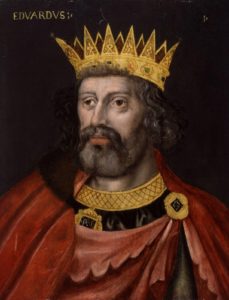
He had difficulty with Scotland when the Scottish line of succession ended in 1292. He executed the Scottish hero Sir William Wallace (Braveheart) in 1306 and was on his way to deal with further rebellion there when he died at Carlisle in July 1307 after a reign of 35 years. He was succeeded by Edward, his fourth and last surviving son, who was born at Caernarvon in 1284 and was the first to bear the title Prince of Wales. Edward I having destroyed the autonomy of Wales by invasion in 1277. Edward, Prince of Wales, was crowned Edward II (aged 23) in 1307. This Edward’s reign is considered to have been the worst in English history. His friend Piers Gaveston, a frivolous favourite, ran the country for the first 2 years of his reign. Gaveston, and Edward II ended the Knights Templar occupation of Subulter. During his reign, England had to endure defeat by the Scots (under Robert I the Bruce) at Bannockburn in 1314 and famine from 1314-15. Piers Gaveston was executed by a baronial committee in 1312. In September 1326 Edward II was deposed in favour of his son, Edward who assumed the throne as Edward III. The deposed king was imprisoned in Berkley Castle near Bristol and was murdered there in September 1327.
Edward III was crowned king in January 1327, aged only 15 years. His mother governed as Regent until 1330 when Edward cast off his father‘s executioners. The knights of the shires met separately for the first time in 1332. The following year they joined with the citizens and Burgesses so that the Parliament was separated into two Houses – an arrangement that persists down to today The knights of the shires, the citizens and the burgesses formed the House of Commons; the spiritual peers and the lay peers formed the House of Lords. Edward assumed the title King of France in 1340 and which launched the Anglo-French conflict know as The 100 Years War.
The Black Death struck in 1349 and the war in France caused troubles for Edward at home. In 1352 he enacted the Statutes of Provisors that allowed him to put in prison all persons in the pope’s service and living in England. His Statutes of Treason 1352 defined the legal meaning of treason that has held good to the present day. The wealth and corruption of the clergy led to the formation of the Lollards in 1356. The Lollards were led by John Wycliffe of York, a master of Balliol College Oxford, who translated the New Testament of the bible to English. His oldest son Edward ‘The Black Prince’ died in 1376. He was a famous warrior in the war with France and was very popular with the people.
By the 1370’s English morale, manpower and financial resources were severely depleted and in 1375 Edward III made a truce with France that lasted until his death in 1377. He had reigned for 50 years. He was succeeded by Richard, son of Edward ‘The Black Prince’. He was 10 years old when he was crowned Richard II in 1377. There were troubled times ahead for the young king as four of his father’s brothers were still alive. One of these, John Duke of Lancaster, known as John of Gaunt, took care of the affairs of state until 1389 when Richard took over. A Parliament called “The Merciless” was convened in 1388 and charged Richard’s friends with treason: some were executed while others were banished.
After a 22-year reign marked by family rivalry and intrigue, in September 1399 Richard abdicated in favour of the son of John of Gaunt -John Bolingbroke Duke of Lancaster who ascended the throne as Henry IV in October 1399. Richard was imprisoned in Pontefract castle where he died of starvation four months later. Henry IV is best remembered as the hero of Shakespeare’s play of the same name. His reign was marked by internal strife and challenges to the legality of his kingship. He died in 1413, apparently of congenital syphilis and was succeeded by his eldest son Henry who was crowned Henry V in 1413. Henry V is best remember for victory against the French at the battle of Agincourt in 1415. As king, his chief ambitions lay in France. He had conquered Normandy and was Regent and heir to the king of France when he died in France in 1322. He was succeeded by his eight-month old son Henry who was Henry VI. He was also proclaimed king of France.
Henry VI was a studious recluse whose inactivity as ruler gave rise to the War of the Roses. His only royal acts were the founding of Eton College in 1440 and King’s College Cambridge in 1447. By 1450 the War of the Roses between Henry’s Lancastrian supporters and the powerful Richard Duke of York (great-grandson of Edward III) was under way. Henry was taken prisoner by York at Northhampton in 1460 but was shortly rescued by the Lancastrians when Richard of York fell.
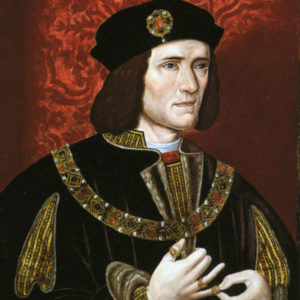
Henry VI reign ended in 1461 when Edward of York, son of the dead duke, proclaimed himself king as Edward IV. After many vicissitudes, Henry was restored in 1470. His reign was short-lived: Edward IV reclaimed the throne in April 1471, Henry was imprisoned in the Tower of London where he was murdered on 21st May. Edward VI improved relations with France and established trade with the Hanseatic League before his death in April 1483. He was succeeded by his younger brother Richard who ruled as Richard III. Richard usurped the throne in June 1483 and imprisoned the sons of Edward VI in the Tower where they were later murdered.
As a usurper, he was opposed by the aristocracy from the start. Henry Tudor Earl of Richmond, an obscure, perhaps illegitimate, Lancastrian claimant living in France, emerged as his main opponent. Henry landed his army in Wales and engaged Richard on Bosworth Field, 12 miles west of Leicester on 7th August 1485. Richard’s nobles deserted him and he was cut to pieces, fighting with vigour against impossible odds. Thus died the last of the Plantagenet dynasty.

